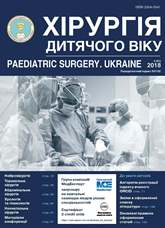Physical features of electric-welding intestinal anastomosis
DOI:
https://doi.org/10.15574/PS.2018.61.69Keywords:
intestine, anastomosis, bursting pressure, elasticity, leakage, swine, experimentAbstract
Several researchers believe that the modulus of elasticity (Young’s) more accurately reflects the mechanical tissue properties and intestinal anastomosis healing rather than bursting pressure, which is a consistent parameter. These measures are not widely used until establishing the structural strength, up to 7-14 days, but electric-welding anastomosis line is characterized by primary structural unity.
Objective: to study the bursting strength and circular anastomosis elasticity, created by high-frequency live tissue welding (HF LTW), and to compare them with clinical requirements.
Material and methods. Under the conditions of an acute experiment, anastomoses measuring 25 mm in diameter created on the swine small intestine were investigated: 16 electro-welded, 4 stapled and 4 single-row sutured ones. The gut segment, 20 cm in length, was slowly filled by coloured NaCl solution up to tightness loss. Anastomosis diameter change was determined simultaneously by its projection on the measuring ruler.
Results. Tissue cutting by staples was noted at a pressure of 24.2±0.8 mm Hg, diameter change of 12%, and Young’s modulus – 384 Pa. The mucosal eversion and start of suture cutting were noted at a pressure of 41.3±5.1 mm Hg, diameter change of 20%, and elasticity – 1093 Pa. The welding line leakage occurred after prolonged uniform stretching, at 53.6±9.8 mm Hg. The diameter change was 40% and elastic constant – 2880 Pa.
Conclusions. The combination of high elasticity and structural homogeneity of electro-welded anastomosis stretching is a relatively more reliable mechanism for avoiding early leakage. The obtained data determine the welding line propulsion involvement resulted in early stool appearance, as well as its resistance to sudden intra-abdominal pressure changes. The latter is an advantage for early patient activation, paediatric surgery and frequently fluid stool cases.
References
Nureyev VN, Leont'yev VM, Vorotnikov AM, Tatarinskiy MV, Revin AN. (1988). Rentgeno-radionuklidnyy metod diagnostiki rannikh oslozhneniy posle operatsii na tolstoy kishke (In Russian). X-ray radionuclide method for early after colon surgery complications diagnosing. Aktual'nyye voprosy spetsializirovannoy meditsinskoy pomoshchi. Moscow: Voyennoye izdatel'stvo: 217–219.
Paton BE, Ivanova OM. (Editors). (2009). Tkanesokhraniayushchaya vysokochastotnaya elektrosvarochnaya khirurgiya (in Russian). The live tissue preserving high-frequency electric welding surgery. Athlas. Kyiv: Naukova Dumka: 193.
Beard JD, Nicholson ML, Sayers RD, Lloyd D, Everson NW. (1990, Oct). Intraoperative air testing of colorectal anastomoses: a prospective, randomized trial. Br J Surg. 77(10): 1095–1097. https://doi.org/10.1002/bjs.1800771006
Bosmans JWAM, Jongen ACHM, Bouvy ND, Derikx JPM. (2015). Colorectal anastomotic healing: why the biological processes that lead to anastomotic leakage should be revealed prior to conducting intervention studies. BMC Gastroenterology. 15: 180. https://doi.org/10.1186/s12876-015-0410-3.
Christensen H, Langfelt S, Laurberg S. (1993). Bursting Strength of Experimental Colonic Anastomoses. A Methodological Study. Eur Surg Res. 25: 38–45. https://doi.org/10.1159/000129255; PMid:8482304
Hendriks T, Mastboom WJB. (1990). Healing of experimental intestinal anastomoses. Parameters for repair. Review. Dis Colon Rectum. 33(10): 891–901. https://doi.org/10.1007/BF02051930; PMid:2209281
Iwanaga TC, Aguiar JL de A, Martins-Filho ED, Kreimer F, Silva–Filho FL, de Albuquerque AV. (2016). Analysis of biomechanical parameters in colonic anastomosis. Arquivos Brasileiros de Cirurgia Digestiva: ABCD. 29(2): 90–92. https://doi.org/10.1590/0102-6720201600020006.
Downloads
Issue
Section
License
The policy of the Journal “PAEDIATRIC SURGERY. UKRAINE” is compatible with the vast majority of funders' of open access and self-archiving policies. The journal provides immediate open access route being convinced that everyone – not only scientists - can benefit from research results, and publishes articles exclusively under open access distribution, with a Creative Commons Attribution-Noncommercial 4.0 international license(СС BY-NC).
Authors transfer the copyright to the Journal “PAEDIATRIC SURGERY.UKRAINE” when the manuscript is accepted for publication. Authors declare that this manuscript has not been published nor is under simultaneous consideration for publication elsewhere. After publication, the articles become freely available on-line to the public.
Readers have the right to use, distribute, and reproduce articles in any medium, provided the articles and the journal are properly cited.
The use of published materials for commercial purposes is strongly prohibited.

